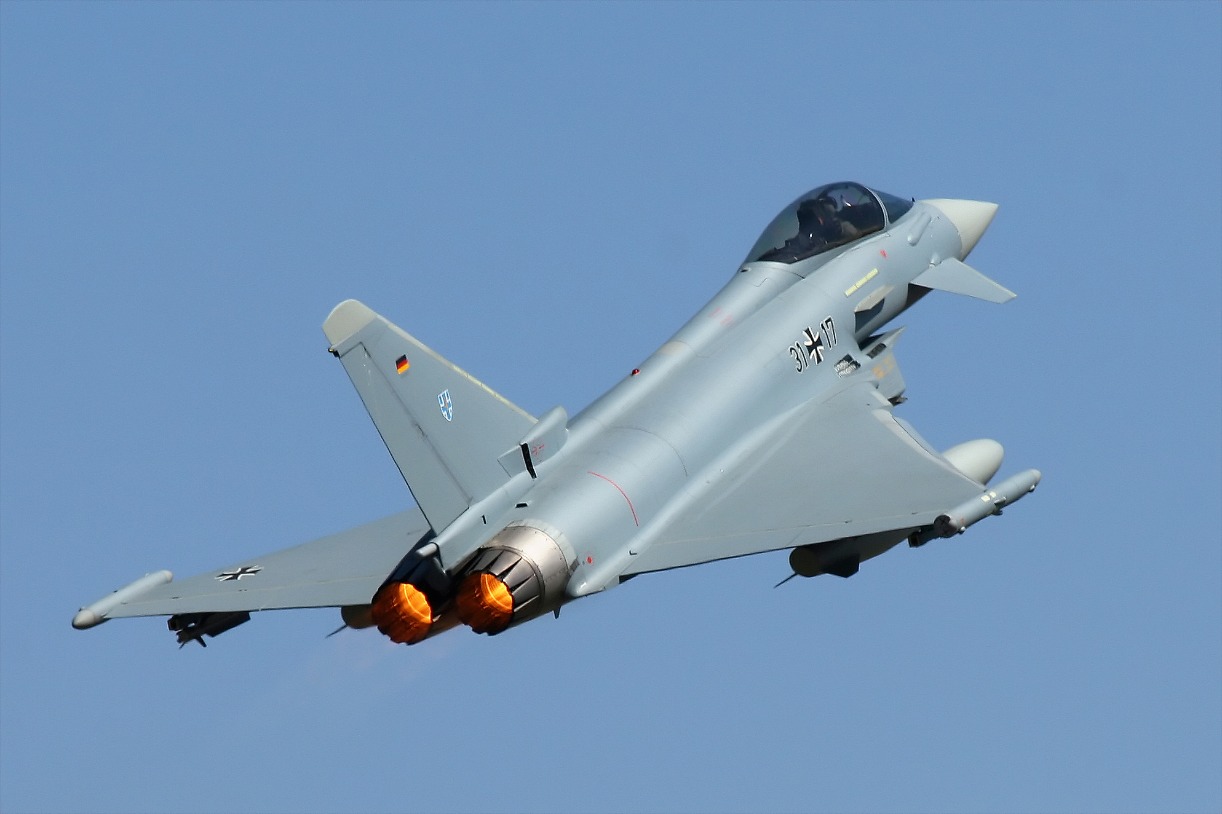The Eurofighter Typhoon Fighter Is an 'Engendered Species'
As sixth-generation fighters emerge, fourth-generation jets like the Eurofighter Typhoon, which debuted in 1994, face uncertain futures.
Summary: As sixth-generation fighters emerge, fourth-generation jets like the Eurofighter Typhoon, which debuted in 1994, face uncertain futures.
Key Points on the Eurofighter Typhoon
-Developed in response to the Soviet threat, the Typhoon is an agile aircraft with advanced features like a relaxed stability design and a quadruplex digital fly-by-wire system.
-Powered by two Eurojet EJ200 engines, it can achieve supercruise without afterburners and potentially include thrust vectoring control.
-Despite its non-stealth design, the Typhoon remains a formidable aircraft, widely used in Europe and the Middle East, with impressive performance characteristics such as Mach 2.35 top speed and a 65,000-foot service ceiling.
The Eurofighter Typhoon: A Fourth-Generation Marvel in a Stealth Era
As aerospace developers move toward a sixth generation of fighter aircraft, many fourth-generation fighters are entering their twilight years. These aircraft face uncertain futures and mounting questions about survivability in contested airspace.
One such non-stealth fourth-generation jet, still widely used, is the Eurofighter Typhoon, which debuted in 1994.
Developing the Eurofighter Typhoon
During the 1980s, the Soviet threat loomed over Western Europe. The nations of that region wanted to counter the threat with appropriate military technology, including aircraft. In 1986, the company Eurofighter was established in Munich to manage a joint effort between the UK, West Germany, Italy, and Spain to develop a fourth-generation fighter that would keep pace with Soviet fighters.
The conclusion of the Cold War meant that the fighter’s anticipated adversary no longer existed, but Eurofighter proceeded nonetheless. There was a moment of peril when German Chancellor Helmut Kohl promised to cancel the project to focus instead on costs related to Germany’s reunification. German Defense Minister Volker Ruhe even sought to withdraw Germany from the project in order to pursue a cheaper and lighter jet.
But by the early 1990s, a great deal of money had already been invested in the Typhoon. Many jobs depended on it, and each partner government had made a binding commitment. Kohl was unable to withdraw. The Eurofighter project proceeded as planned.
Designing the Eurofighter Typhoon
The Typhoon is an agile aircraft at both supersonic and subsonic speeds. That agility is the result of a relaxed stability design. To assist the pilot in what is essentially an unstable aircraft, the Typhoon is equipped with a quadruplex digital fly-by-wire control system that provides artificial stability to compensate for the jet’s design. The Typhoon’s fly-by-wire system has been described as “carefree” and controls each of the jet’s flight surfaces, from its delta wing and canards to the large vertical rudder.
The Typhoon was outfitted with two Eurojet EJ200 engines. Each EJ200 provides up to 13,500 pounds of thrust dry, and 20,230 pounds with afterburner engaged. The engine also has a “war” setting that allows for a boost in thrust for a few seconds (15% increase dry, and 5% increase with afterburner). The EJ200 is a sophisticated engine, with advanced digital control and health monitoring, wide chord aerofoils, single crystal turbine blades, and convergent/divergent exhaust nozzles. The engine allows the Typhoon to operate with a high thrust-to-weight ratio, multimission capability, supercruise performance, low fuel consumption, low cost of ownership, modular construction, and growth potential.
It is impressive that the Typhoon can achieve supercruise flight, which is supersonic speed without the use of afterburners. Supercruise is more commonly associated with fifth-generation fighters. Yet the fourth-generation Typhoon can indeed supercruise. Eurofighter claims the jet can hit Mach 1.5 in the supercruise setting.
The EJ200 can also be fitted with thrust vectoring control (TVC), another technological feature more commonly associated with fifth-generation aircraft. TVC allows the engine outlet to pivot, which offers precision control over the engine exhaust. The jet in this capacity is even more maneuverable.
Flying the Eurofighter Typhoon
The Typhoon has been heralded for its flight characteristics. Former U.S. Air Force Chief of Staff Gen. John P. Jumper was impressed after taking the Typhoon for a flight. “The Eurofighter is both agile and sophisticated,” Jumper said. “The Eurofighter is certainly, as far as smoothness of controls and the ability to pull (and sustain high G forces), very impressive. That is what it was designed to do, especially the version I flew, with the avionics, the color moving map displays, etc. – all absolutely top notch. The maneuverability of the airplane in close-in combat was also very impressive.”
Jumper was hardly the only convert. Eurofighter found an enthusiastic foreign market for the Typhoon fighter, and the jet is in operation with air forces throughout Europe and the Middle East. The jet has performed admirably, with a top speed of Mach 2.35, an 1,800-mile range, and a 65,000-foot service ceiling. The jet can climb at 62,000 feet per minute and sustain g-force ratings of +9/-3.

While the future of the Eurofighter in an environment where stealth is so highly valued remains uncertain, the jet has done the job it was designed to do.
About the Author: Harrison Kass
Harrison Kass is a defense and national security writer with over 1,300 total pieces on issues involving global affairs. An attorney, pilot, guitarist, and minor pro hockey player, Harrison joined the US Air Force as a Pilot Trainee but was medically discharged. Harrison holds a BA from Lake Forest College, a JD from the University of Oregon, and an MA from New York University. Harrison listens to Dokken.
All images are Creative Commons.


